Leading and Managing Business: Diversity, Theories & Sainsbury's Case
VerifiedAdded on 2023/06/04
|11
|2823
|128
Report
AI Summary
This report examines the critical aspects of leading and managing business organizations, focusing on diversity management and the application of management theories. It highlights the importance of managing diversity among staff, addressing challenges such as communication issues, gender inequality, and cultural differences within organizations like Sainsbury's. The report also delves into scientific management theories and the rational goal theory, discussing their characteristics, implications for human resource management, and advantages for organizations. It emphasizes the need for managers to foster a healthy work environment by avoiding discrimination and promoting inclusivity. The analysis concludes that effective diversity management and the application of relevant management theories are crucial for organizational growth and performance.
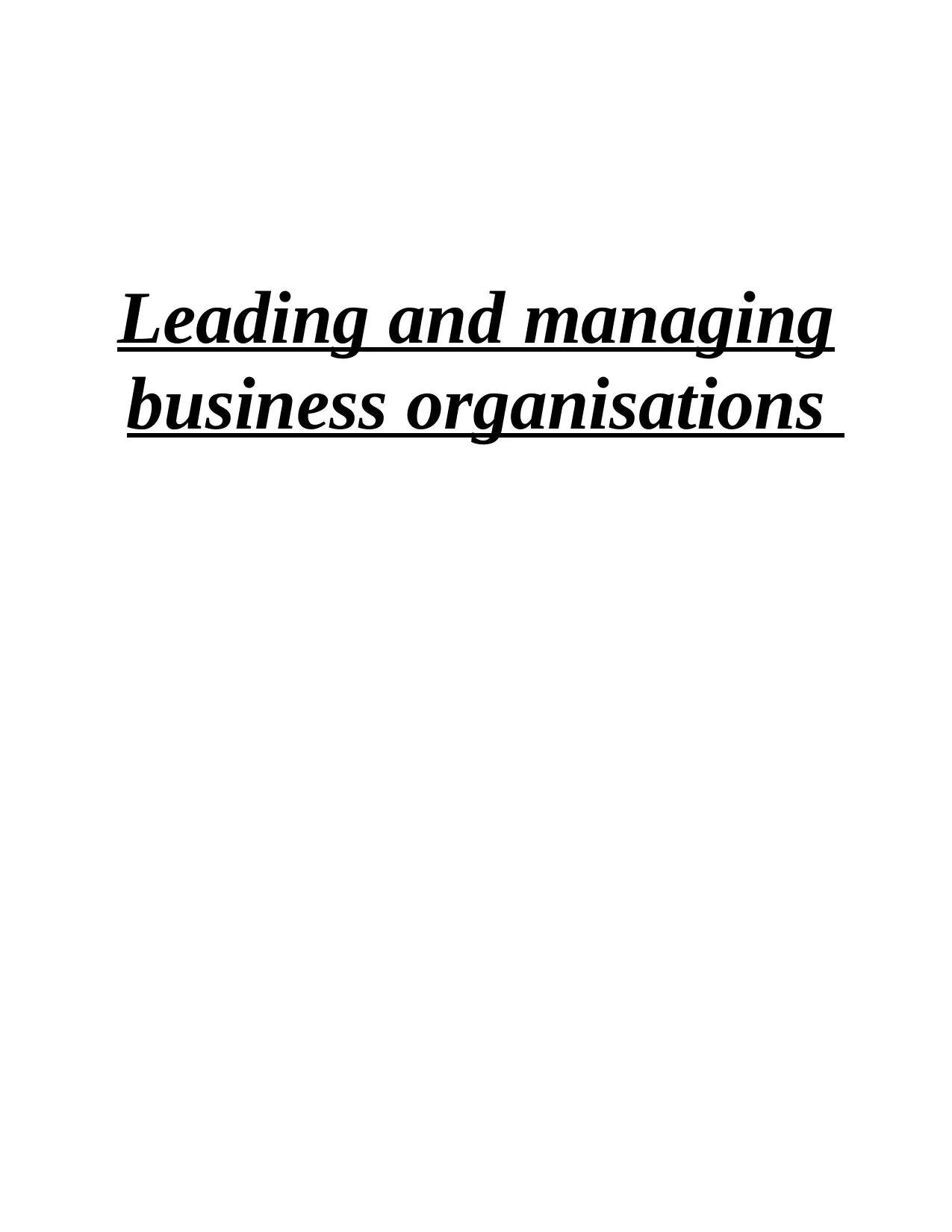
Leading and managing
business organisations
business organisations
Paraphrase This Document
Need a fresh take? Get an instant paraphrase of this document with our AI Paraphraser
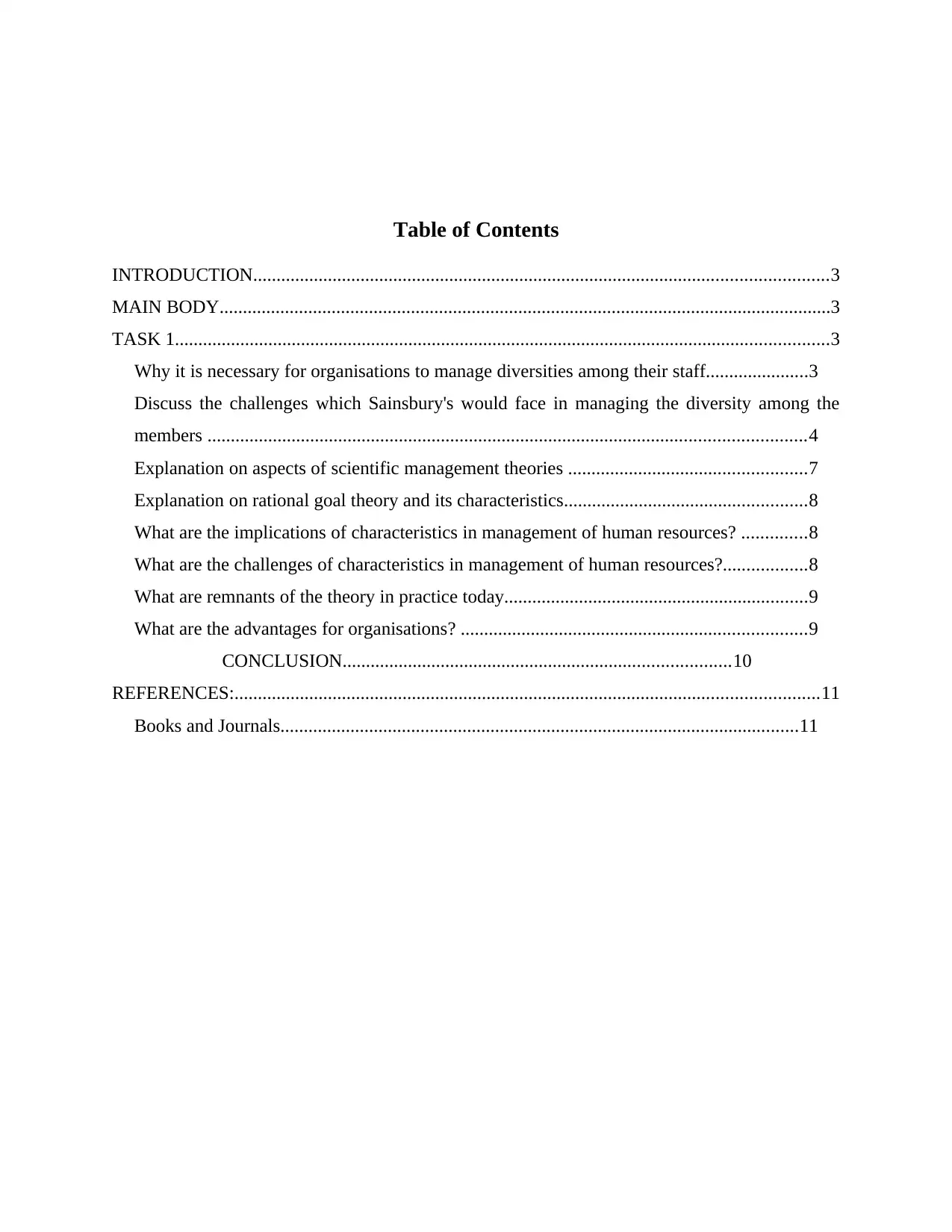
Table of Contents
INTRODUCTION...........................................................................................................................3
MAIN BODY...................................................................................................................................3
TASK 1............................................................................................................................................3
Why it is necessary for organisations to manage diversities among their staff......................3
Discuss the challenges which Sainsbury's would face in managing the diversity among the
members ................................................................................................................................4
Explanation on aspects of scientific management theories ...................................................7
Explanation on rational goal theory and its characteristics....................................................8
What are the implications of characteristics in management of human resources? ..............8
What are the challenges of characteristics in management of human resources?..................8
What are remnants of the theory in practice today.................................................................9
What are the advantages for organisations? ..........................................................................9
CONCLUSION...................................................................................10
REFERENCES:.............................................................................................................................11
Books and Journals...............................................................................................................11
INTRODUCTION...........................................................................................................................3
MAIN BODY...................................................................................................................................3
TASK 1............................................................................................................................................3
Why it is necessary for organisations to manage diversities among their staff......................3
Discuss the challenges which Sainsbury's would face in managing the diversity among the
members ................................................................................................................................4
Explanation on aspects of scientific management theories ...................................................7
Explanation on rational goal theory and its characteristics....................................................8
What are the implications of characteristics in management of human resources? ..............8
What are the challenges of characteristics in management of human resources?..................8
What are remnants of the theory in practice today.................................................................9
What are the advantages for organisations? ..........................................................................9
CONCLUSION...................................................................................10
REFERENCES:.............................................................................................................................11
Books and Journals...............................................................................................................11
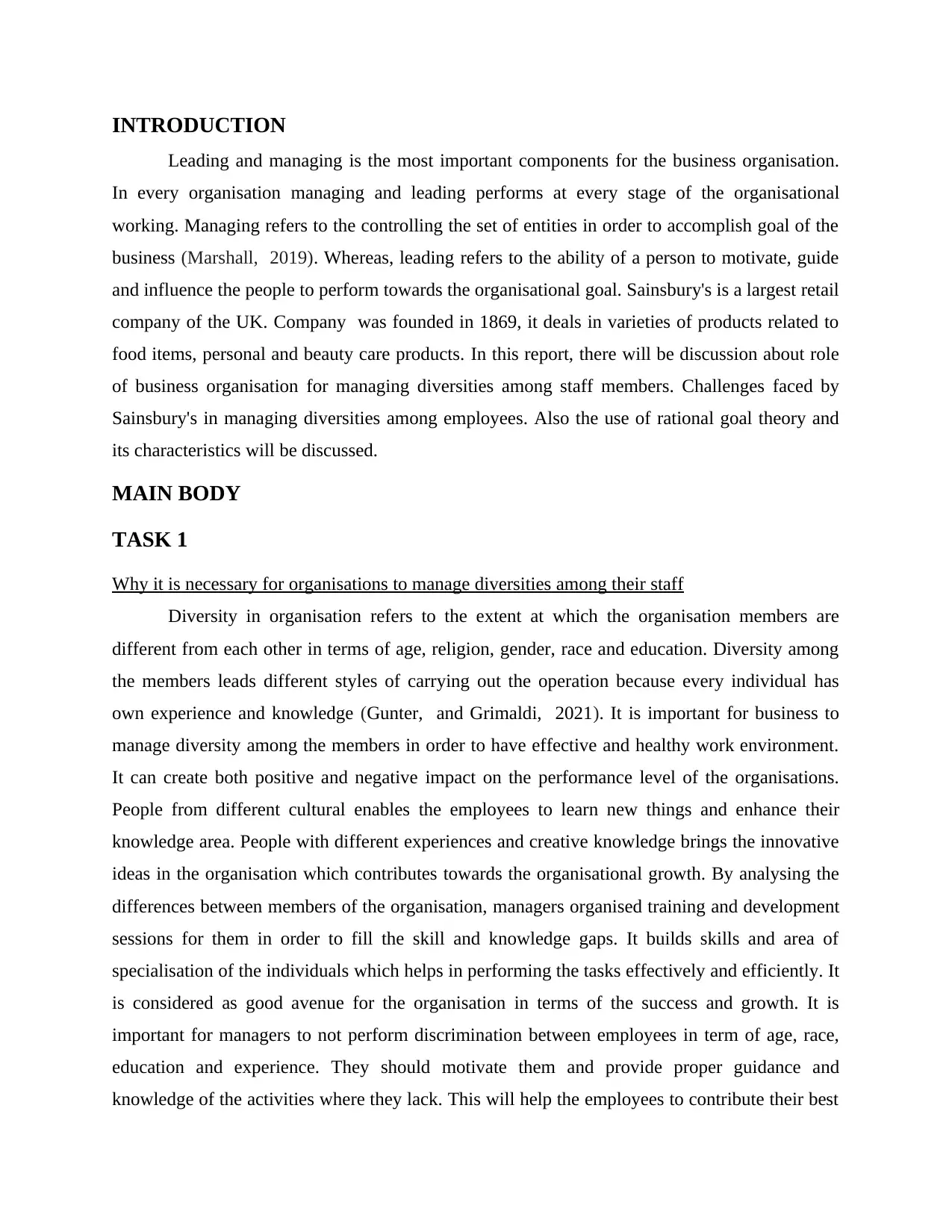
INTRODUCTION
Leading and managing is the most important components for the business organisation.
In every organisation managing and leading performs at every stage of the organisational
working. Managing refers to the controlling the set of entities in order to accomplish goal of the
business (Marshall, 2019). Whereas, leading refers to the ability of a person to motivate, guide
and influence the people to perform towards the organisational goal. Sainsbury's is a largest retail
company of the UK. Company was founded in 1869, it deals in varieties of products related to
food items, personal and beauty care products. In this report, there will be discussion about role
of business organisation for managing diversities among staff members. Challenges faced by
Sainsbury's in managing diversities among employees. Also the use of rational goal theory and
its characteristics will be discussed.
MAIN BODY
TASK 1
Why it is necessary for organisations to manage diversities among their staff
Diversity in organisation refers to the extent at which the organisation members are
different from each other in terms of age, religion, gender, race and education. Diversity among
the members leads different styles of carrying out the operation because every individual has
own experience and knowledge (Gunter, and Grimaldi, 2021). It is important for business to
manage diversity among the members in order to have effective and healthy work environment.
It can create both positive and negative impact on the performance level of the organisations.
People from different cultural enables the employees to learn new things and enhance their
knowledge area. People with different experiences and creative knowledge brings the innovative
ideas in the organisation which contributes towards the organisational growth. By analysing the
differences between members of the organisation, managers organised training and development
sessions for them in order to fill the skill and knowledge gaps. It builds skills and area of
specialisation of the individuals which helps in performing the tasks effectively and efficiently. It
is considered as good avenue for the organisation in terms of the success and growth. It is
important for managers to not perform discrimination between employees in term of age, race,
education and experience. They should motivate them and provide proper guidance and
knowledge of the activities where they lack. This will help the employees to contribute their best
Leading and managing is the most important components for the business organisation.
In every organisation managing and leading performs at every stage of the organisational
working. Managing refers to the controlling the set of entities in order to accomplish goal of the
business (Marshall, 2019). Whereas, leading refers to the ability of a person to motivate, guide
and influence the people to perform towards the organisational goal. Sainsbury's is a largest retail
company of the UK. Company was founded in 1869, it deals in varieties of products related to
food items, personal and beauty care products. In this report, there will be discussion about role
of business organisation for managing diversities among staff members. Challenges faced by
Sainsbury's in managing diversities among employees. Also the use of rational goal theory and
its characteristics will be discussed.
MAIN BODY
TASK 1
Why it is necessary for organisations to manage diversities among their staff
Diversity in organisation refers to the extent at which the organisation members are
different from each other in terms of age, religion, gender, race and education. Diversity among
the members leads different styles of carrying out the operation because every individual has
own experience and knowledge (Gunter, and Grimaldi, 2021). It is important for business to
manage diversity among the members in order to have effective and healthy work environment.
It can create both positive and negative impact on the performance level of the organisations.
People from different cultural enables the employees to learn new things and enhance their
knowledge area. People with different experiences and creative knowledge brings the innovative
ideas in the organisation which contributes towards the organisational growth. By analysing the
differences between members of the organisation, managers organised training and development
sessions for them in order to fill the skill and knowledge gaps. It builds skills and area of
specialisation of the individuals which helps in performing the tasks effectively and efficiently. It
is considered as good avenue for the organisation in terms of the success and growth. It is
important for managers to not perform discrimination between employees in term of age, race,
education and experience. They should motivate them and provide proper guidance and
knowledge of the activities where they lack. This will help the employees to contribute their best
⊘ This is a preview!⊘
Do you want full access?
Subscribe today to unlock all pages.

Trusted by 1+ million students worldwide
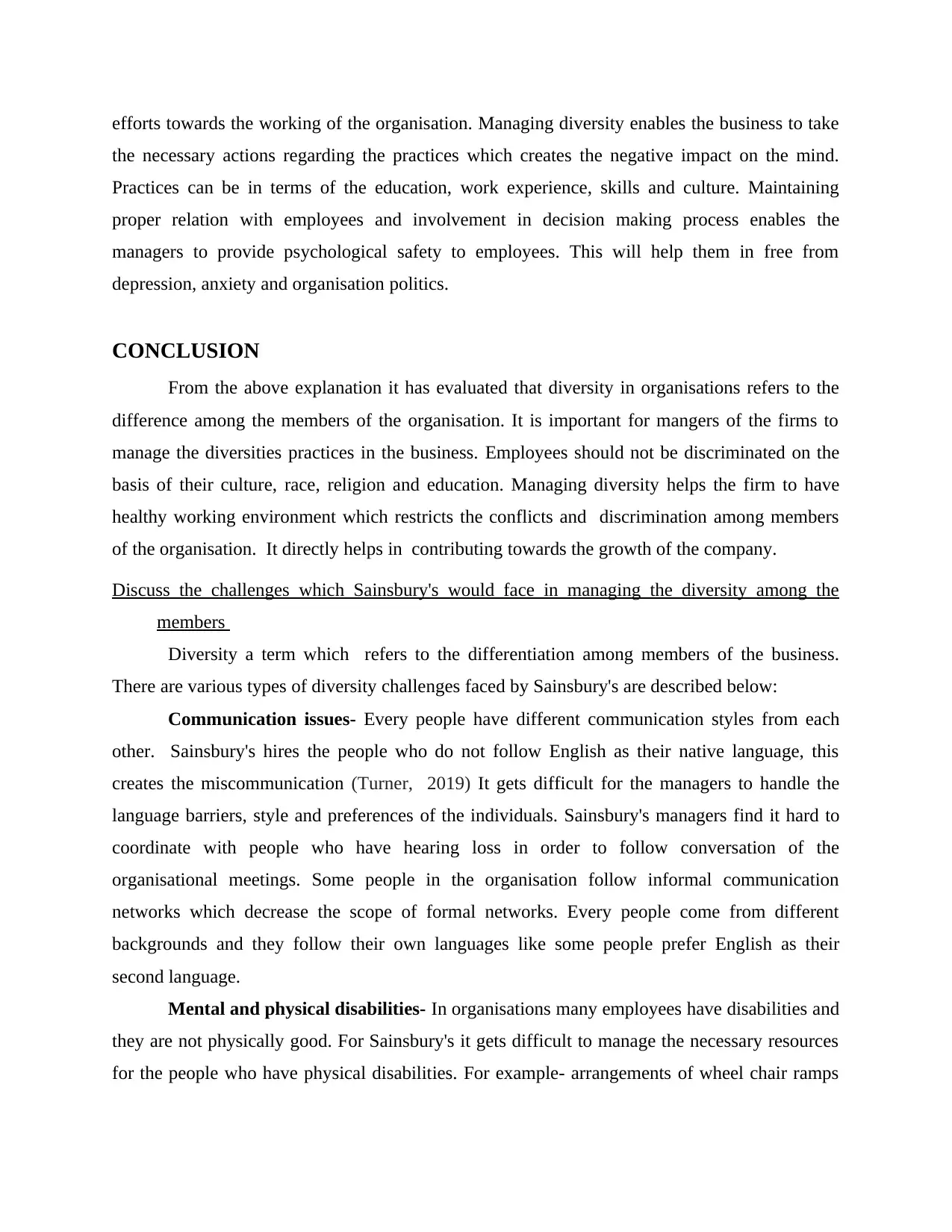
efforts towards the working of the organisation. Managing diversity enables the business to take
the necessary actions regarding the practices which creates the negative impact on the mind.
Practices can be in terms of the education, work experience, skills and culture. Maintaining
proper relation with employees and involvement in decision making process enables the
managers to provide psychological safety to employees. This will help them in free from
depression, anxiety and organisation politics.
CONCLUSION
From the above explanation it has evaluated that diversity in organisations refers to the
difference among the members of the organisation. It is important for mangers of the firms to
manage the diversities practices in the business. Employees should not be discriminated on the
basis of their culture, race, religion and education. Managing diversity helps the firm to have
healthy working environment which restricts the conflicts and discrimination among members
of the organisation. It directly helps in contributing towards the growth of the company.
Discuss the challenges which Sainsbury's would face in managing the diversity among the
members
Diversity a term which refers to the differentiation among members of the business.
There are various types of diversity challenges faced by Sainsbury's are described below:
Communication issues- Every people have different communication styles from each
other. Sainsbury's hires the people who do not follow English as their native language, this
creates the miscommunication (Turner, 2019) It gets difficult for the managers to handle the
language barriers, style and preferences of the individuals. Sainsbury's managers find it hard to
coordinate with people who have hearing loss in order to follow conversation of the
organisational meetings. Some people in the organisation follow informal communication
networks which decrease the scope of formal networks. Every people come from different
backgrounds and they follow their own languages like some people prefer English as their
second language.
Mental and physical disabilities- In organisations many employees have disabilities and
they are not physically good. For Sainsbury's it gets difficult to manage the necessary resources
for the people who have physical disabilities. For example- arrangements of wheel chair ramps
the necessary actions regarding the practices which creates the negative impact on the mind.
Practices can be in terms of the education, work experience, skills and culture. Maintaining
proper relation with employees and involvement in decision making process enables the
managers to provide psychological safety to employees. This will help them in free from
depression, anxiety and organisation politics.
CONCLUSION
From the above explanation it has evaluated that diversity in organisations refers to the
difference among the members of the organisation. It is important for mangers of the firms to
manage the diversities practices in the business. Employees should not be discriminated on the
basis of their culture, race, religion and education. Managing diversity helps the firm to have
healthy working environment which restricts the conflicts and discrimination among members
of the organisation. It directly helps in contributing towards the growth of the company.
Discuss the challenges which Sainsbury's would face in managing the diversity among the
members
Diversity a term which refers to the differentiation among members of the business.
There are various types of diversity challenges faced by Sainsbury's are described below:
Communication issues- Every people have different communication styles from each
other. Sainsbury's hires the people who do not follow English as their native language, this
creates the miscommunication (Turner, 2019) It gets difficult for the managers to handle the
language barriers, style and preferences of the individuals. Sainsbury's managers find it hard to
coordinate with people who have hearing loss in order to follow conversation of the
organisational meetings. Some people in the organisation follow informal communication
networks which decrease the scope of formal networks. Every people come from different
backgrounds and they follow their own languages like some people prefer English as their
second language.
Mental and physical disabilities- In organisations many employees have disabilities and
they are not physically good. For Sainsbury's it gets difficult to manage the necessary resources
for the people who have physical disabilities. For example- arrangements of wheel chair ramps
Paraphrase This Document
Need a fresh take? Get an instant paraphrase of this document with our AI Paraphraser
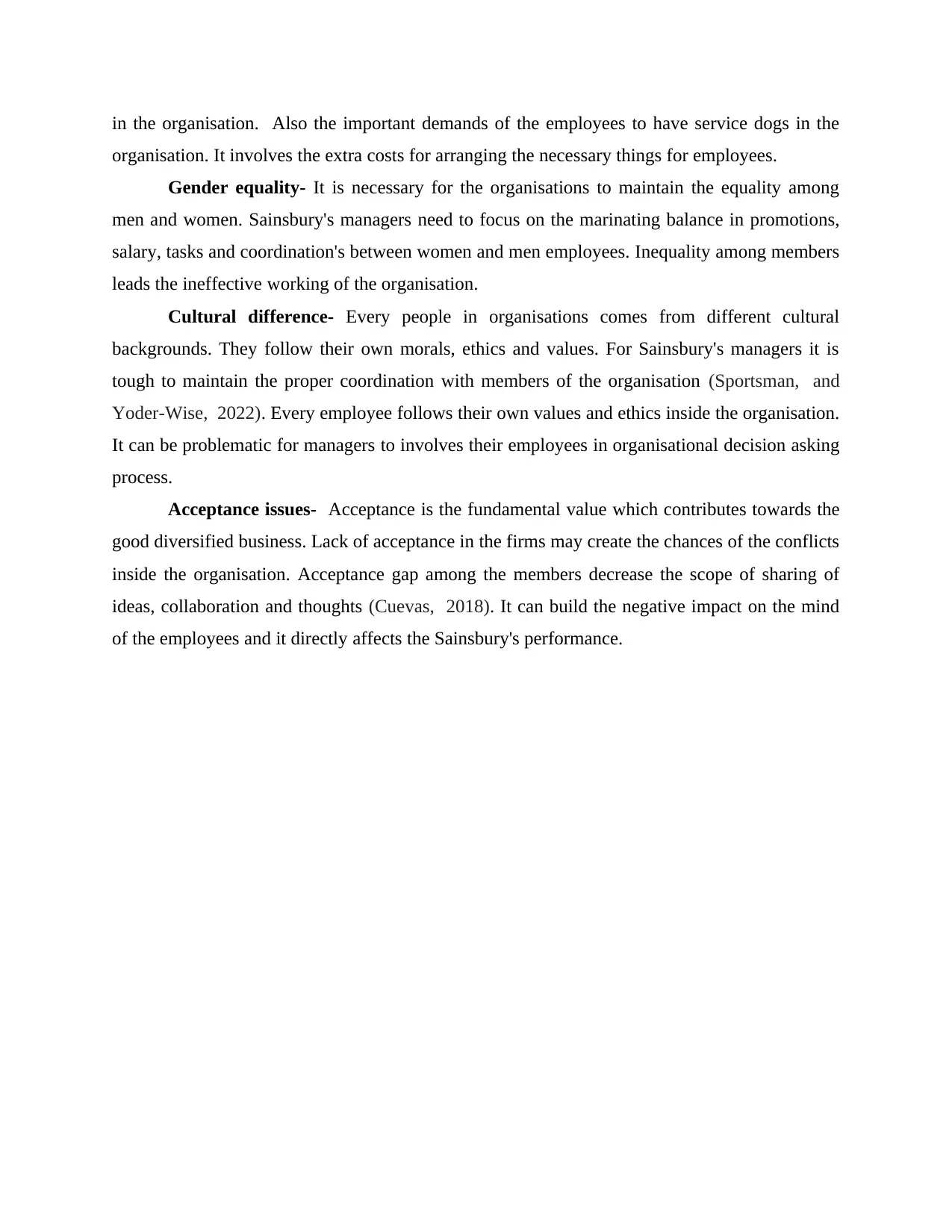
in the organisation. Also the important demands of the employees to have service dogs in the
organisation. It involves the extra costs for arranging the necessary things for employees.
Gender equality- It is necessary for the organisations to maintain the equality among
men and women. Sainsbury's managers need to focus on the marinating balance in promotions,
salary, tasks and coordination's between women and men employees. Inequality among members
leads the ineffective working of the organisation.
Cultural difference- Every people in organisations comes from different cultural
backgrounds. They follow their own morals, ethics and values. For Sainsbury's managers it is
tough to maintain the proper coordination with members of the organisation (Sportsman, and
Yoder-Wise, 2022). Every employee follows their own values and ethics inside the organisation.
It can be problematic for managers to involves their employees in organisational decision asking
process.
Acceptance issues- Acceptance is the fundamental value which contributes towards the
good diversified business. Lack of acceptance in the firms may create the chances of the conflicts
inside the organisation. Acceptance gap among the members decrease the scope of sharing of
ideas, collaboration and thoughts (Cuevas, 2018). It can build the negative impact on the mind
of the employees and it directly affects the Sainsbury's performance.
organisation. It involves the extra costs for arranging the necessary things for employees.
Gender equality- It is necessary for the organisations to maintain the equality among
men and women. Sainsbury's managers need to focus on the marinating balance in promotions,
salary, tasks and coordination's between women and men employees. Inequality among members
leads the ineffective working of the organisation.
Cultural difference- Every people in organisations comes from different cultural
backgrounds. They follow their own morals, ethics and values. For Sainsbury's managers it is
tough to maintain the proper coordination with members of the organisation (Sportsman, and
Yoder-Wise, 2022). Every employee follows their own values and ethics inside the organisation.
It can be problematic for managers to involves their employees in organisational decision asking
process.
Acceptance issues- Acceptance is the fundamental value which contributes towards the
good diversified business. Lack of acceptance in the firms may create the chances of the conflicts
inside the organisation. Acceptance gap among the members decrease the scope of sharing of
ideas, collaboration and thoughts (Cuevas, 2018). It can build the negative impact on the mind
of the employees and it directly affects the Sainsbury's performance.
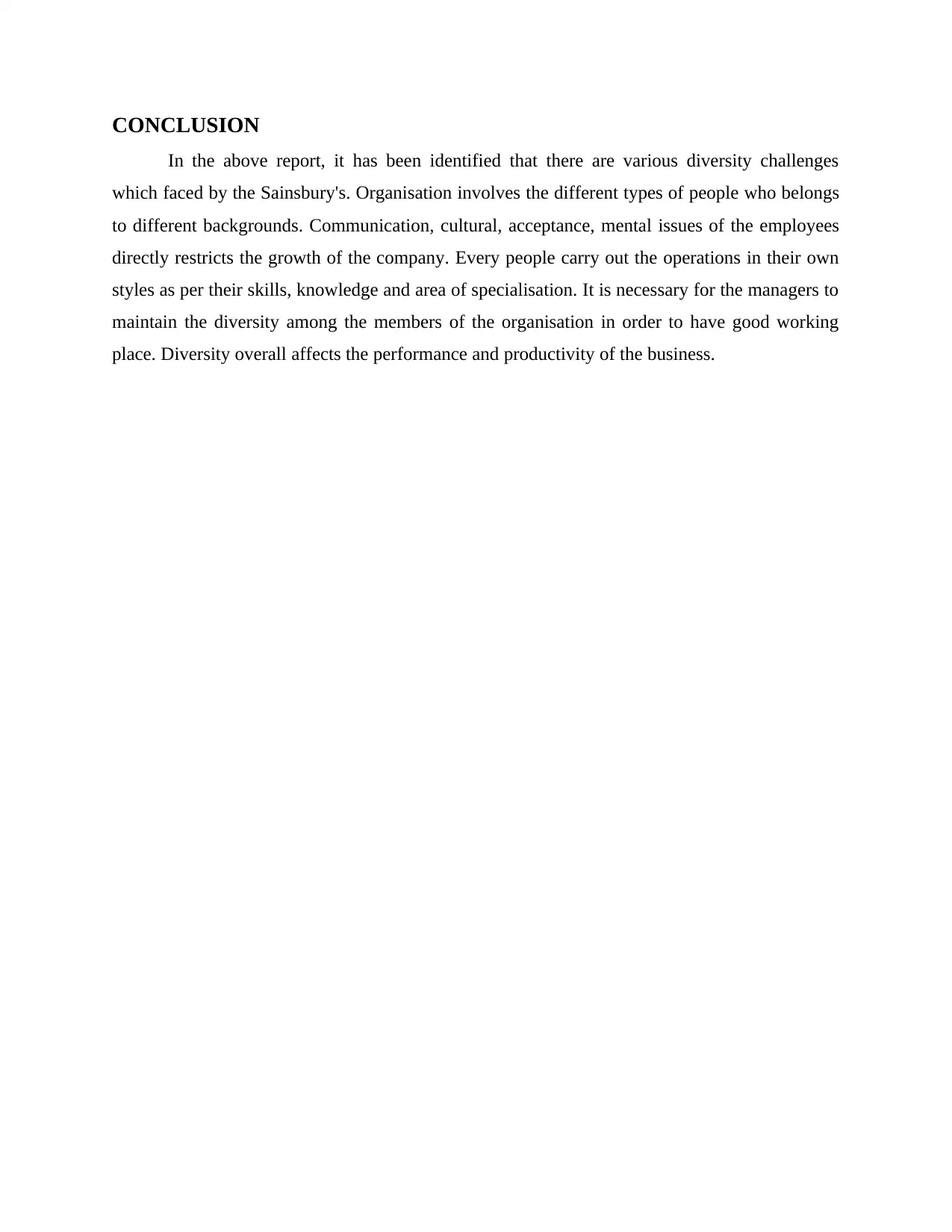
CONCLUSION
In the above report, it has been identified that there are various diversity challenges
which faced by the Sainsbury's. Organisation involves the different types of people who belongs
to different backgrounds. Communication, cultural, acceptance, mental issues of the employees
directly restricts the growth of the company. Every people carry out the operations in their own
styles as per their skills, knowledge and area of specialisation. It is necessary for the managers to
maintain the diversity among the members of the organisation in order to have good working
place. Diversity overall affects the performance and productivity of the business.
In the above report, it has been identified that there are various diversity challenges
which faced by the Sainsbury's. Organisation involves the different types of people who belongs
to different backgrounds. Communication, cultural, acceptance, mental issues of the employees
directly restricts the growth of the company. Every people carry out the operations in their own
styles as per their skills, knowledge and area of specialisation. It is necessary for the managers to
maintain the diversity among the members of the organisation in order to have good working
place. Diversity overall affects the performance and productivity of the business.
⊘ This is a preview!⊘
Do you want full access?
Subscribe today to unlock all pages.

Trusted by 1+ million students worldwide
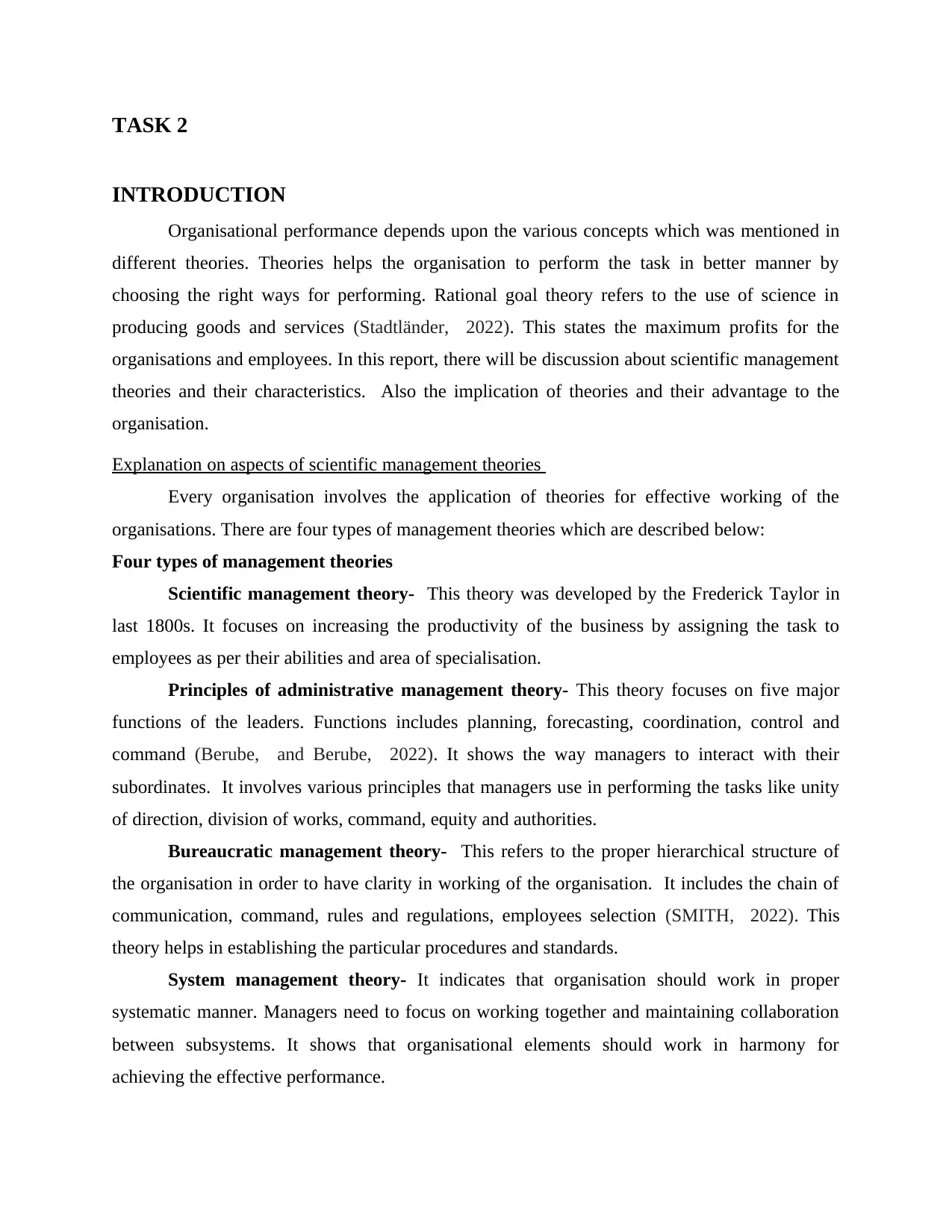
TASK 2
INTRODUCTION
Organisational performance depends upon the various concepts which was mentioned in
different theories. Theories helps the organisation to perform the task in better manner by
choosing the right ways for performing. Rational goal theory refers to the use of science in
producing goods and services (Stadtländer, 2022). This states the maximum profits for the
organisations and employees. In this report, there will be discussion about scientific management
theories and their characteristics. Also the implication of theories and their advantage to the
organisation.
Explanation on aspects of scientific management theories
Every organisation involves the application of theories for effective working of the
organisations. There are four types of management theories which are described below:
Four types of management theories
Scientific management theory- This theory was developed by the Frederick Taylor in
last 1800s. It focuses on increasing the productivity of the business by assigning the task to
employees as per their abilities and area of specialisation.
Principles of administrative management theory- This theory focuses on five major
functions of the leaders. Functions includes planning, forecasting, coordination, control and
command (Berube, and Berube, 2022). It shows the way managers to interact with their
subordinates. It involves various principles that managers use in performing the tasks like unity
of direction, division of works, command, equity and authorities.
Bureaucratic management theory- This refers to the proper hierarchical structure of
the organisation in order to have clarity in working of the organisation. It includes the chain of
communication, command, rules and regulations, employees selection (SMITH, 2022). This
theory helps in establishing the particular procedures and standards.
System management theory- It indicates that organisation should work in proper
systematic manner. Managers need to focus on working together and maintaining collaboration
between subsystems. It shows that organisational elements should work in harmony for
achieving the effective performance.
INTRODUCTION
Organisational performance depends upon the various concepts which was mentioned in
different theories. Theories helps the organisation to perform the task in better manner by
choosing the right ways for performing. Rational goal theory refers to the use of science in
producing goods and services (Stadtländer, 2022). This states the maximum profits for the
organisations and employees. In this report, there will be discussion about scientific management
theories and their characteristics. Also the implication of theories and their advantage to the
organisation.
Explanation on aspects of scientific management theories
Every organisation involves the application of theories for effective working of the
organisations. There are four types of management theories which are described below:
Four types of management theories
Scientific management theory- This theory was developed by the Frederick Taylor in
last 1800s. It focuses on increasing the productivity of the business by assigning the task to
employees as per their abilities and area of specialisation.
Principles of administrative management theory- This theory focuses on five major
functions of the leaders. Functions includes planning, forecasting, coordination, control and
command (Berube, and Berube, 2022). It shows the way managers to interact with their
subordinates. It involves various principles that managers use in performing the tasks like unity
of direction, division of works, command, equity and authorities.
Bureaucratic management theory- This refers to the proper hierarchical structure of
the organisation in order to have clarity in working of the organisation. It includes the chain of
communication, command, rules and regulations, employees selection (SMITH, 2022). This
theory helps in establishing the particular procedures and standards.
System management theory- It indicates that organisation should work in proper
systematic manner. Managers need to focus on working together and maintaining collaboration
between subsystems. It shows that organisational elements should work in harmony for
achieving the effective performance.
Paraphrase This Document
Need a fresh take? Get an instant paraphrase of this document with our AI Paraphraser
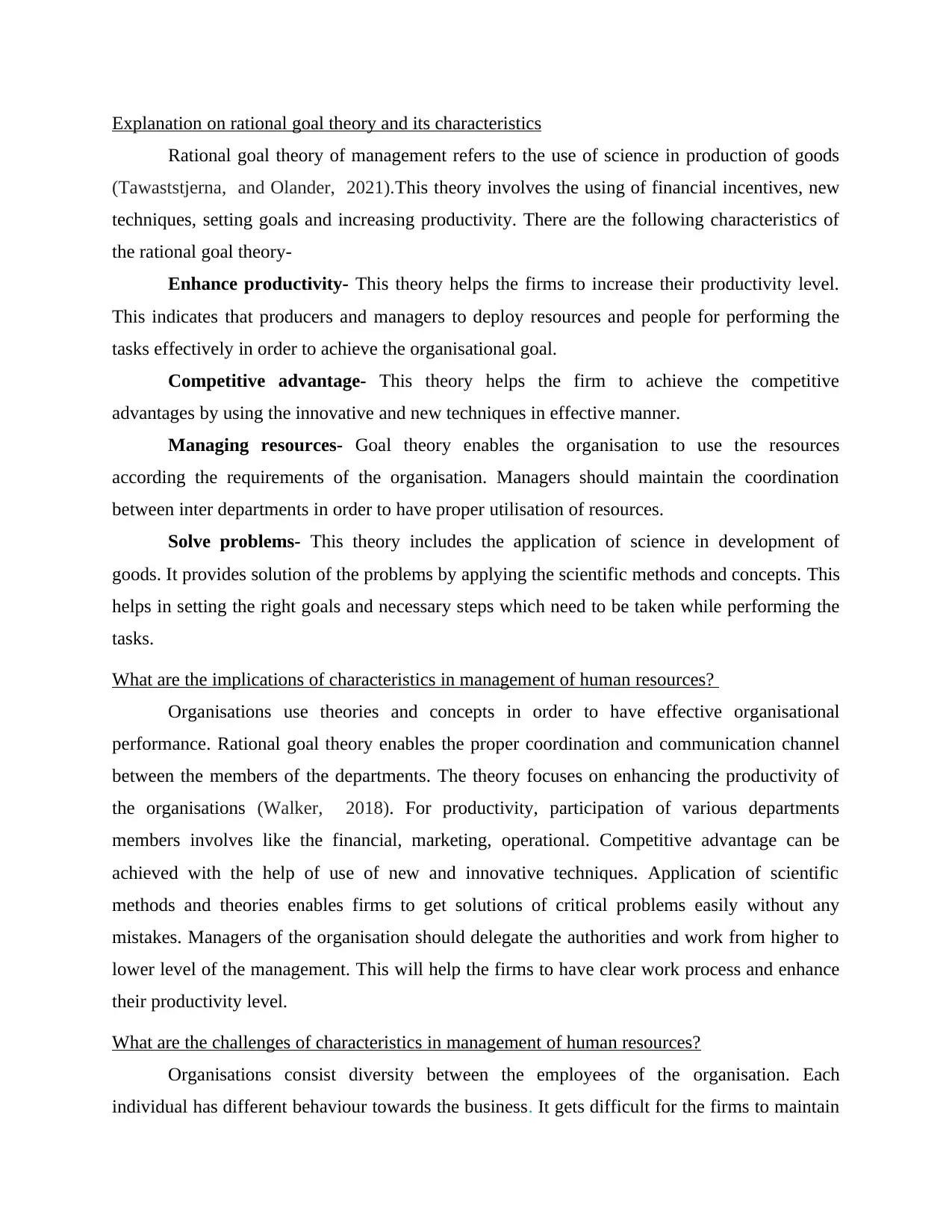
Explanation on rational goal theory and its characteristics
Rational goal theory of management refers to the use of science in production of goods
(Tawaststjerna, and Olander, 2021).This theory involves the using of financial incentives, new
techniques, setting goals and increasing productivity. There are the following characteristics of
the rational goal theory-
Enhance productivity- This theory helps the firms to increase their productivity level.
This indicates that producers and managers to deploy resources and people for performing the
tasks effectively in order to achieve the organisational goal.
Competitive advantage- This theory helps the firm to achieve the competitive
advantages by using the innovative and new techniques in effective manner.
Managing resources- Goal theory enables the organisation to use the resources
according the requirements of the organisation. Managers should maintain the coordination
between inter departments in order to have proper utilisation of resources.
Solve problems- This theory includes the application of science in development of
goods. It provides solution of the problems by applying the scientific methods and concepts. This
helps in setting the right goals and necessary steps which need to be taken while performing the
tasks.
What are the implications of characteristics in management of human resources?
Organisations use theories and concepts in order to have effective organisational
performance. Rational goal theory enables the proper coordination and communication channel
between the members of the departments. The theory focuses on enhancing the productivity of
the organisations (Walker, 2018). For productivity, participation of various departments
members involves like the financial, marketing, operational. Competitive advantage can be
achieved with the help of use of new and innovative techniques. Application of scientific
methods and theories enables firms to get solutions of critical problems easily without any
mistakes. Managers of the organisation should delegate the authorities and work from higher to
lower level of the management. This will help the firms to have clear work process and enhance
their productivity level.
What are the challenges of characteristics in management of human resources?
Organisations consist diversity between the employees of the organisation. Each
individual has different behaviour towards the business. It gets difficult for the firms to maintain
Rational goal theory of management refers to the use of science in production of goods
(Tawaststjerna, and Olander, 2021).This theory involves the using of financial incentives, new
techniques, setting goals and increasing productivity. There are the following characteristics of
the rational goal theory-
Enhance productivity- This theory helps the firms to increase their productivity level.
This indicates that producers and managers to deploy resources and people for performing the
tasks effectively in order to achieve the organisational goal.
Competitive advantage- This theory helps the firm to achieve the competitive
advantages by using the innovative and new techniques in effective manner.
Managing resources- Goal theory enables the organisation to use the resources
according the requirements of the organisation. Managers should maintain the coordination
between inter departments in order to have proper utilisation of resources.
Solve problems- This theory includes the application of science in development of
goods. It provides solution of the problems by applying the scientific methods and concepts. This
helps in setting the right goals and necessary steps which need to be taken while performing the
tasks.
What are the implications of characteristics in management of human resources?
Organisations use theories and concepts in order to have effective organisational
performance. Rational goal theory enables the proper coordination and communication channel
between the members of the departments. The theory focuses on enhancing the productivity of
the organisations (Walker, 2018). For productivity, participation of various departments
members involves like the financial, marketing, operational. Competitive advantage can be
achieved with the help of use of new and innovative techniques. Application of scientific
methods and theories enables firms to get solutions of critical problems easily without any
mistakes. Managers of the organisation should delegate the authorities and work from higher to
lower level of the management. This will help the firms to have clear work process and enhance
their productivity level.
What are the challenges of characteristics in management of human resources?
Organisations consist diversity between the employees of the organisation. Each
individual has different behaviour towards the business. It gets difficult for the firms to maintain
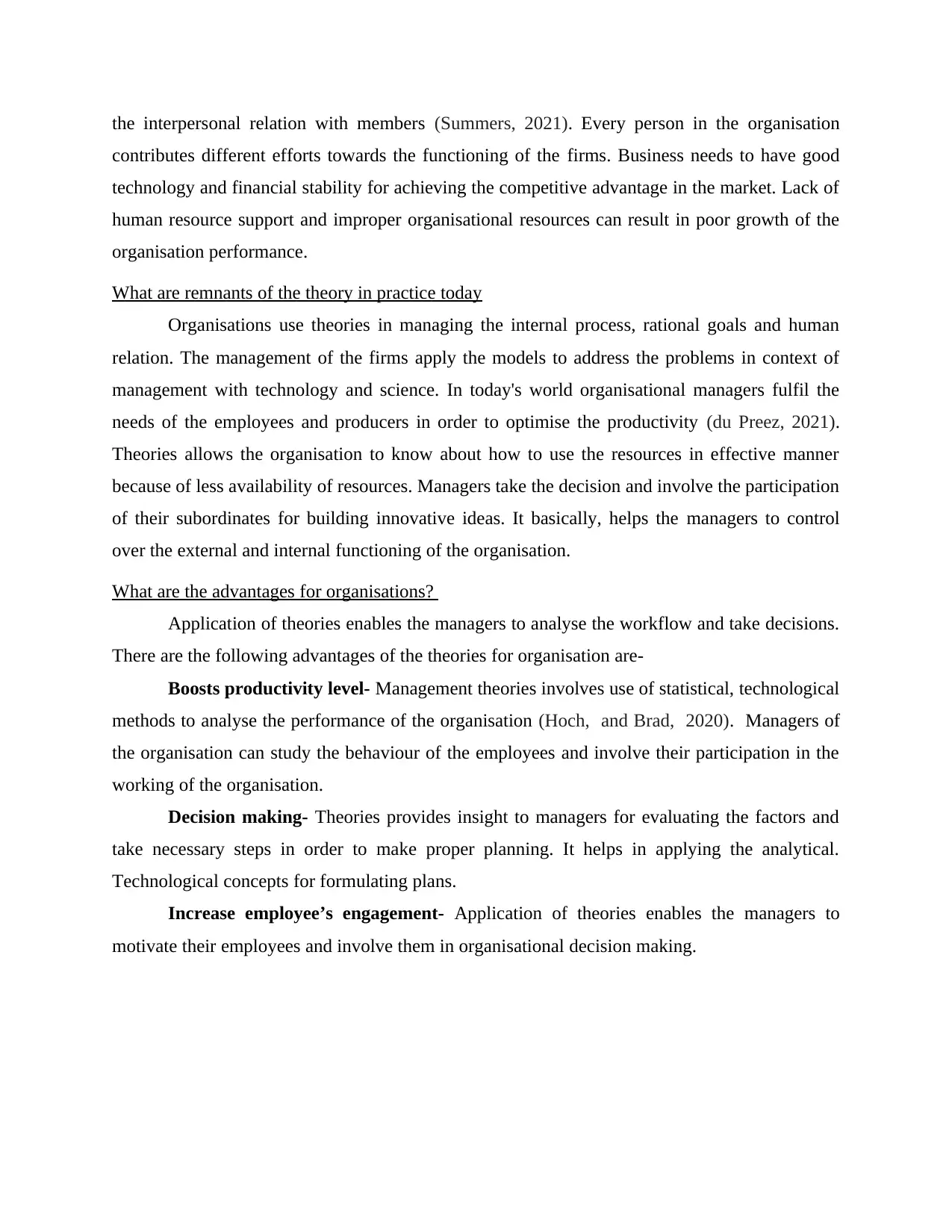
the interpersonal relation with members (Summers, 2021). Every person in the organisation
contributes different efforts towards the functioning of the firms. Business needs to have good
technology and financial stability for achieving the competitive advantage in the market. Lack of
human resource support and improper organisational resources can result in poor growth of the
organisation performance.
What are remnants of the theory in practice today
Organisations use theories in managing the internal process, rational goals and human
relation. The management of the firms apply the models to address the problems in context of
management with technology and science. In today's world organisational managers fulfil the
needs of the employees and producers in order to optimise the productivity (du Preez, 2021).
Theories allows the organisation to know about how to use the resources in effective manner
because of less availability of resources. Managers take the decision and involve the participation
of their subordinates for building innovative ideas. It basically, helps the managers to control
over the external and internal functioning of the organisation.
What are the advantages for organisations?
Application of theories enables the managers to analyse the workflow and take decisions.
There are the following advantages of the theories for organisation are-
Boosts productivity level- Management theories involves use of statistical, technological
methods to analyse the performance of the organisation (Hoch, and Brad, 2020). Managers of
the organisation can study the behaviour of the employees and involve their participation in the
working of the organisation.
Decision making- Theories provides insight to managers for evaluating the factors and
take necessary steps in order to make proper planning. It helps in applying the analytical.
Technological concepts for formulating plans.
Increase employee’s engagement- Application of theories enables the managers to
motivate their employees and involve them in organisational decision making.
contributes different efforts towards the functioning of the firms. Business needs to have good
technology and financial stability for achieving the competitive advantage in the market. Lack of
human resource support and improper organisational resources can result in poor growth of the
organisation performance.
What are remnants of the theory in practice today
Organisations use theories in managing the internal process, rational goals and human
relation. The management of the firms apply the models to address the problems in context of
management with technology and science. In today's world organisational managers fulfil the
needs of the employees and producers in order to optimise the productivity (du Preez, 2021).
Theories allows the organisation to know about how to use the resources in effective manner
because of less availability of resources. Managers take the decision and involve the participation
of their subordinates for building innovative ideas. It basically, helps the managers to control
over the external and internal functioning of the organisation.
What are the advantages for organisations?
Application of theories enables the managers to analyse the workflow and take decisions.
There are the following advantages of the theories for organisation are-
Boosts productivity level- Management theories involves use of statistical, technological
methods to analyse the performance of the organisation (Hoch, and Brad, 2020). Managers of
the organisation can study the behaviour of the employees and involve their participation in the
working of the organisation.
Decision making- Theories provides insight to managers for evaluating the factors and
take necessary steps in order to make proper planning. It helps in applying the analytical.
Technological concepts for formulating plans.
Increase employee’s engagement- Application of theories enables the managers to
motivate their employees and involve them in organisational decision making.
⊘ This is a preview!⊘
Do you want full access?
Subscribe today to unlock all pages.

Trusted by 1+ million students worldwide
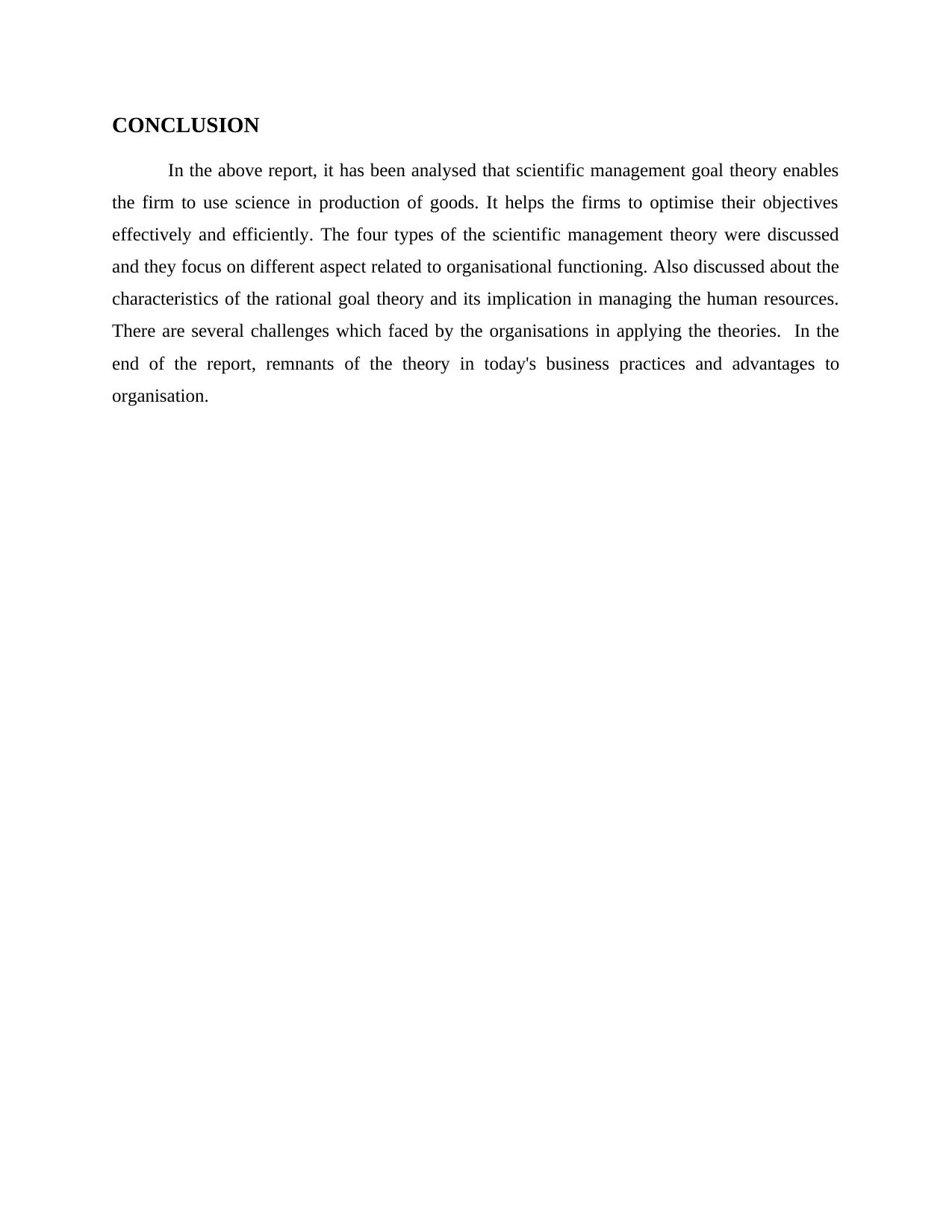
CONCLUSION
In the above report, it has been analysed that scientific management goal theory enables
the firm to use science in production of goods. It helps the firms to optimise their objectives
effectively and efficiently. The four types of the scientific management theory were discussed
and they focus on different aspect related to organisational functioning. Also discussed about the
characteristics of the rational goal theory and its implication in managing the human resources.
There are several challenges which faced by the organisations in applying the theories. In the
end of the report, remnants of the theory in today's business practices and advantages to
organisation.
In the above report, it has been analysed that scientific management goal theory enables
the firm to use science in production of goods. It helps the firms to optimise their objectives
effectively and efficiently. The four types of the scientific management theory were discussed
and they focus on different aspect related to organisational functioning. Also discussed about the
characteristics of the rational goal theory and its implication in managing the human resources.
There are several challenges which faced by the organisations in applying the theories. In the
end of the report, remnants of the theory in today's business practices and advantages to
organisation.
Paraphrase This Document
Need a fresh take? Get an instant paraphrase of this document with our AI Paraphraser
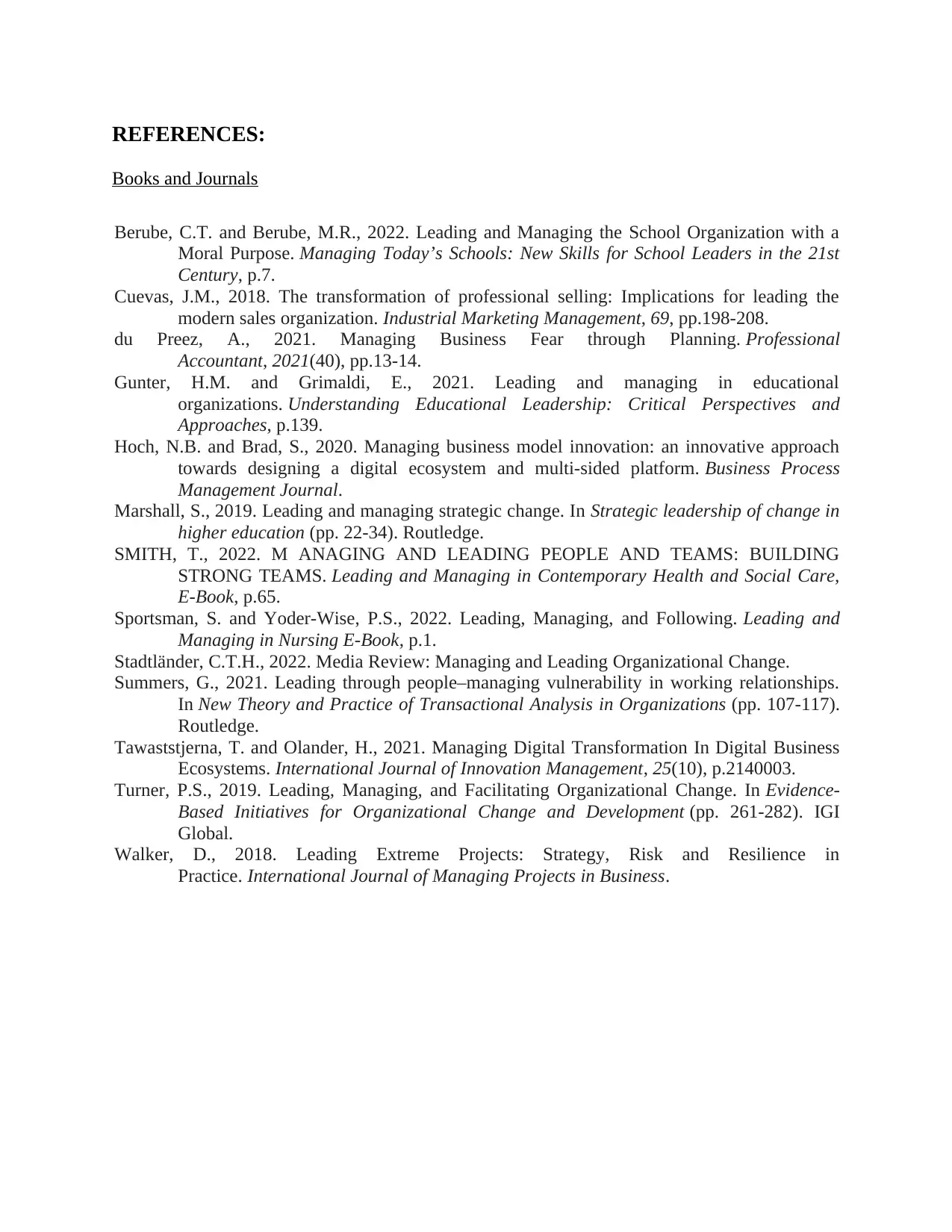
REFERENCES:
Books and Journals
Berube, C.T. and Berube, M.R., 2022. Leading and Managing the School Organization with a
Moral Purpose. Managing Today’s Schools: New Skills for School Leaders in the 21st
Century, p.7.
Cuevas, J.M., 2018. The transformation of professional selling: Implications for leading the
modern sales organization. Industrial Marketing Management, 69, pp.198-208.
du Preez, A., 2021. Managing Business Fear through Planning. Professional
Accountant, 2021(40), pp.13-14.
Gunter, H.M. and Grimaldi, E., 2021. Leading and managing in educational
organizations. Understanding Educational Leadership: Critical Perspectives and
Approaches, p.139.
Hoch, N.B. and Brad, S., 2020. Managing business model innovation: an innovative approach
towards designing a digital ecosystem and multi-sided platform. Business Process
Management Journal.
Marshall, S., 2019. Leading and managing strategic change. In Strategic leadership of change in
higher education (pp. 22-34). Routledge.
SMITH, T., 2022. M ANAGING AND LEADING PEOPLE AND TEAMS: BUILDING
STRONG TEAMS. Leading and Managing in Contemporary Health and Social Care,
E-Book, p.65.
Sportsman, S. and Yoder-Wise, P.S., 2022. Leading, Managing, and Following. Leading and
Managing in Nursing E-Book, p.1.
Stadtländer, C.T.H., 2022. Media Review: Managing and Leading Organizational Change.
Summers, G., 2021. Leading through people–managing vulnerability in working relationships.
In New Theory and Practice of Transactional Analysis in Organizations (pp. 107-117).
Routledge.
Tawaststjerna, T. and Olander, H., 2021. Managing Digital Transformation In Digital Business
Ecosystems. International Journal of Innovation Management, 25(10), p.2140003.
Turner, P.S., 2019. Leading, Managing, and Facilitating Organizational Change. In Evidence-
Based Initiatives for Organizational Change and Development (pp. 261-282). IGI
Global.
Walker, D., 2018. Leading Extreme Projects: Strategy, Risk and Resilience in
Practice. International Journal of Managing Projects in Business.
Books and Journals
Berube, C.T. and Berube, M.R., 2022. Leading and Managing the School Organization with a
Moral Purpose. Managing Today’s Schools: New Skills for School Leaders in the 21st
Century, p.7.
Cuevas, J.M., 2018. The transformation of professional selling: Implications for leading the
modern sales organization. Industrial Marketing Management, 69, pp.198-208.
du Preez, A., 2021. Managing Business Fear through Planning. Professional
Accountant, 2021(40), pp.13-14.
Gunter, H.M. and Grimaldi, E., 2021. Leading and managing in educational
organizations. Understanding Educational Leadership: Critical Perspectives and
Approaches, p.139.
Hoch, N.B. and Brad, S., 2020. Managing business model innovation: an innovative approach
towards designing a digital ecosystem and multi-sided platform. Business Process
Management Journal.
Marshall, S., 2019. Leading and managing strategic change. In Strategic leadership of change in
higher education (pp. 22-34). Routledge.
SMITH, T., 2022. M ANAGING AND LEADING PEOPLE AND TEAMS: BUILDING
STRONG TEAMS. Leading and Managing in Contemporary Health and Social Care,
E-Book, p.65.
Sportsman, S. and Yoder-Wise, P.S., 2022. Leading, Managing, and Following. Leading and
Managing in Nursing E-Book, p.1.
Stadtländer, C.T.H., 2022. Media Review: Managing and Leading Organizational Change.
Summers, G., 2021. Leading through people–managing vulnerability in working relationships.
In New Theory and Practice of Transactional Analysis in Organizations (pp. 107-117).
Routledge.
Tawaststjerna, T. and Olander, H., 2021. Managing Digital Transformation In Digital Business
Ecosystems. International Journal of Innovation Management, 25(10), p.2140003.
Turner, P.S., 2019. Leading, Managing, and Facilitating Organizational Change. In Evidence-
Based Initiatives for Organizational Change and Development (pp. 261-282). IGI
Global.
Walker, D., 2018. Leading Extreme Projects: Strategy, Risk and Resilience in
Practice. International Journal of Managing Projects in Business.
1 out of 11
Related Documents
Your All-in-One AI-Powered Toolkit for Academic Success.
+13062052269
info@desklib.com
Available 24*7 on WhatsApp / Email
![[object Object]](/_next/static/media/star-bottom.7253800d.svg)
Unlock your academic potential
Copyright © 2020–2025 A2Z Services. All Rights Reserved. Developed and managed by ZUCOL.





